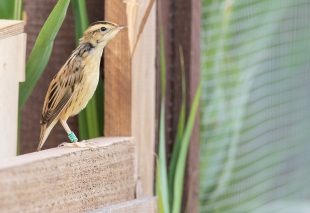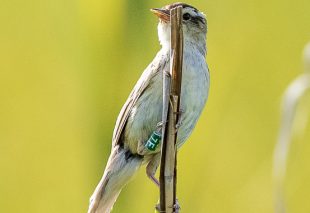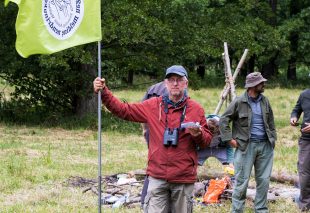
A unique and special peatland complex
Sporovsky reserve is one of the largest natural protected wetland complexes in Europe. Due to it’s size, the ecosystem of this wetland remains stable and is not dependent on changes in the surrounding areas.
Lake Sporovsky and the Jaselda river flow through the center of the reserve. The main part of the reserve area (42,2%) is occupied by low marshes with mosaic islands with bushes. There are also hills and elevations (mineral soil islands) within such large area. In the past, these mineral islands were overgrown with oaks and pine trees, but later they were cut down and these areas were used as pastures and meadows. At present, most farmers have given up farming and natural vegetation is recovering here.
123 nesting bird species are found in this reserve. Globally endangered Aquatic warblers also breed here, this is the area with the highest Aquatic warblers density is home to 9% of the world’s population. Corncrakes and great Snipes are also found in the Sporovsky reserve together with other 20 species, that are listed in Red Data Book of Belarus. In addition, the reserve has populations of Great Bitterns of natural importance and black storks of national importance.
Sporovsky reserve – educational routes
Sporovsky reserve is rich in educational trails. You will find five of them here:
Educational route “In a land of Aquatic warbler”
The route begins with a descent through a pine forest, visitors along the slope going to the bank of the Jaselda river, crossing the river to the opposite bank, then the route passes through the lowland, returning to the left bank of the Jaselda river, then up along the slope through the pine forest towards the visitor centre.
The main educational topics of the route: characteristics of water bodies and rivers, wetlands as special water bodies, their role in nature and human life, peatland flora and fauna, human impact on natural complexes, drainage, ecosystems, food chains, plant life forms, protected plant and animal species, the uniqueness of the Sporovsky peat.
Length of the route: 2 km.
Mode of travel: walking route.
Average duration: 3 hours.
Seasonality: the optimal time is from April to September.
Number of parking spaces: 8.
1-hour of tour costs 1 ruble per person.
More information about route and additional services: https://www.itourist.by/tours/v-krayu-kamishovkic
Educational route “Jaselda river”
In this educational route you will travel by boat or kayak through Jaselda river and lake Sporovsky. The purpose of this educational route is to learn more about wetland animals, birds, vegetation and landscape. You can also observe amphibians during the trip, and fish in the shallow water. Moreover you can see some mammals, such as Eurasian beaver, European and American minks, Eurasian otter and muskrat.
Birds like Mute swans, Mallards, Gadwalls, Eurasian coots, Common moorhens, Garganeys, Great crested grebes, Black-headed, Little and Common gulls can be observed in this area. In addition to waterfowl, you can also see Little egrets, Grey herons, Western marsh harriers. From rare birds – White tailed sea eagles, Black storks, Great white egrets, Great and Little bitterns, Short-eared owls, Corncrakes, Aquatic warblers, etc.
Those, who are interested, can also be introduced to the life of the villages of Sporova and Kokoritsa and buy handmade souvenirs.
Length of the route: 20 km.
Mode of travel: by boat or kayak.
Average duration: 2 days (by rowing boat) or about 8 hours (by motor boat).
Number of people: up to 9 people in rowing boats or up to 3 people in motor boat.
Seasonality: the optimal time is from May to October.
In addition to have: rubber boots.
More information about route and additional services: https://www.itourist.by/tours/po-yaselde-reke
Educational route “Unique Sporovsky lake”
It is a nature trail through the wetlands and forests of the reserve, where you will see a rich complex of rare plant species and a diverse world of birds. The main objects that tourists will be able to learn about are the biological features of the wetlands and mineral islands that can be seen along the route. First of all, these are botanical objects and wetlands. Hikers will also be able to see animals, birds and insects living in the lake region.
Length of the route: 6 km.
Mode of travel: walking route.
Seasonality: the optimal time is from May to July.
In addition to have: rubber boots and binoculars.
More information about route and additional services: https://www.itourist.by/tours/unikalnoe-ozero-sporovskoe
Educational route “Heritage of Palese”
It is an all-day sightseeing route for those who want to get to know the local traditions and see the rich diversity of wildlife. The route begins at the Bezdesh village Ethnographic Museum, where you can see a variety of exhibits and purchase souvenirs made by local artisans. There is also a visit to the Church of the Holy Trinity. Later the route continues to a more natural side, visiting wetlands with diverse waterfowl, colonies of Great white egrets and nests of black storks.
Upon the arrival to the village of Kokoritsa, there is an opportunity to interact with local people, see traditional crafts, buy local products and souvenirs. You can go horse riding, boating. The trip continues for 2 km by foot or riding a horse (rented by locals) and then continuing by boat across lake Sporovky. While swimming in the lake, it is possible to observe rare species of birds and plants. On the shore of the lake there is an old manor where you can organize lunch, relax after a hike and so on.
Length of the route: 15-20 km.
Mode of travel: walking route, boating, if desired – a few kilometers horseriding.
Seasonality: the optimal time is from April to October.
More information about route and additional services: https://www.itourist.by/tours/palesskaya-spadchyna
Explore the Sporovsky reserve by bike
The route begins by exploring the Jaselda flood zone. Here you will see a river dam, a natural massif of low marshes. You can see everything from above there is a 6 m high observation tower.
In addition to the rich flora, visitors can observe the various bird species living in the reserve. Forest birds – Woodpeckers, Eurasian jays, Hoopoes, Great tits, Fieldfares, Common cuckoos, etc. Birds, common at lowland marshes – Little egrets, Grey herons, Western marsh harriers, Common buzzards, various species of waders (Eurasian curlews, Common and Great snipes, Common redshanks, etc.). From rare species you can see such as White-tailed eagles, Great white egrets, Great and Little bitterns, Short-eared owls, Corncrakes, Aquatic warblers, etc.).
The route then follows the field road, which is the boundary of the reserve, to the village of Storomlyny. Here you can see the process of restoring the damaged landscape. Because the area is very flooded, many water birds live here.
Later you can visit the ancient village near Staromlyny and Zamkovaya Gora villages (an early Iron Age settlement in the village of Zhaber on the right bank of the Jaselda river). The return to the base is planned in another way with the oppurtunity to visit the farms, where you can learn more about the life of local residents and walk to lake Belo. From the lake shore you can see the entire lake, the fish farm. You can arrange swimming in the lake.
Important! Bicycles can be rented in the administrative building of the Sporovsky reserve. You will be accompanied by the reserve staff during the trip. Meals – independently or by prior arrangement.
Length of the route: 20 km.
Mode of travel: by bicycle.
Seasonality: the optimal time is from April to October.
More information about route and additional services: https://www.itourist.by/tours/sporovskoe-velo
Important information
During all trips you will be accompanied by the staff of the reserve, therefore it is necessary to contact the administration of the reserve:
Address: Puskin st., 23 b., Berez, Brest region
Telephone/fax number (+ 375 1643) 2-22-31
Leading specialist Nikolaj Stepanovich
Email: rbz_sporovskij@tut.by












No comments!